A Pastoral Symphony
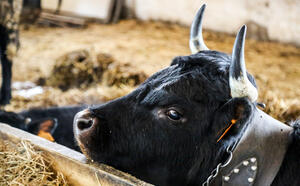
Farming in the Chamonix Mont-Blanc Valley in 2023
What a joy to watch a shepherd pass by with his flock of sheep, to contemplate cattle, ruminating peacefully in flower-filled meadows, to hear the nostalgic sound of bells, or to come across playful goat kids, vying for their mother's attention.
These simple moments, so close to nature, awaken our senses... so too does a mouthwatering array of cheeses at a local farm, or the aroma of artisan bread hot out of the oven, of vegetables straight from the soil and honey harvested by the grace of those same flower-filled meadows!
Thanks to the energy and passion of a small farming community in the Chamonix Valley, we are fortunate to be able to share in these simple pleasures, hopefully for many years to come. Come along and meet the men and women who are committed to a pastoral way of life, taking great pride in their activity and their local production.
First of all, to understand the stakes of today, it is necessary to take a step back in time
The first writings of the Chamonix Valley date from 1091, and they already evoke the Alps (name which designates the summits and mountain pastures). For centuries, long before the arrival of tourism, the inhabitants lived off the land. Each family owned a handful of animals, between one and five cows, or failing that, a few goats, not forgetting the pig!
Just like today, hay was a precious resource, wasting it was out of the question! The cows were relocated to the high alpine pastures during the summer months, and during this period the grass was cut for hay in the valley. Indeed, a huge amount of forage was necessary to feed the cattle during the long white winter months (November to May) when they had no choice but to remain in the cow shed.
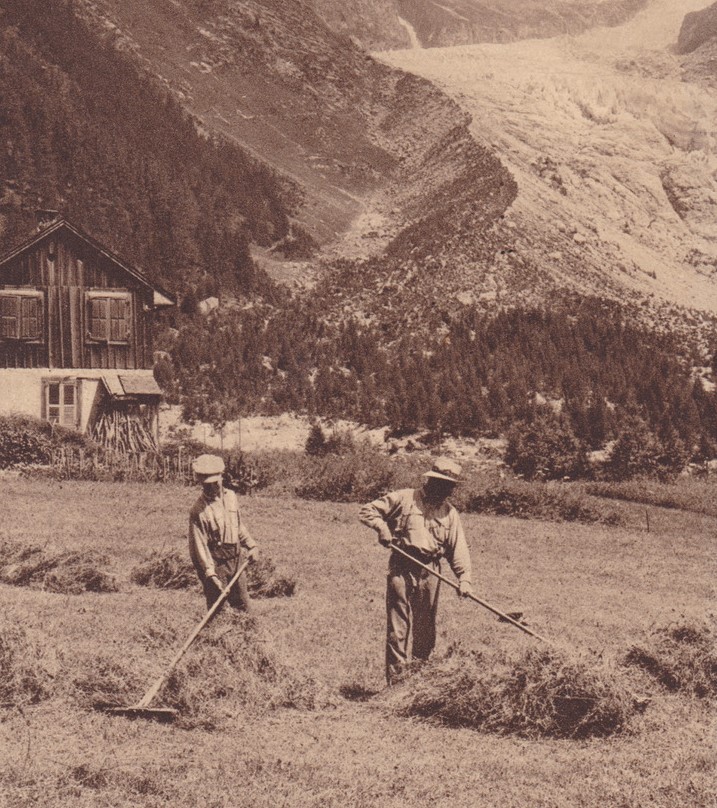
Fenaison à Argentière
In the past, the cheese that was sold at the nearest markets represented the main source of income for the peasant farmers. Thanks to the mountain pastures, they could exploit the land below for hay, cereals and vegetables. From the 1700s, the potato claimed a prominent place in the daily diet of mountain dwellers. According to recordings, honey from the Chamonix valley was also highly coveted!
When we talk about mountain pastures, these are meadows located between 1700 and 2000m - representing over 2000 hectares in the Chamonix valley - which have been cleared and developed across many centuries, for an exploitation of only three months in the summer. The mountain pastures and their dwellings were owned collectively by those who grazed their cattle and participated in the upkeep of the mountain. These people were, and still are, known as "consorts". Each village had its allocated mountain pasture! The grazing capacity of each "mountain" depended on iits surface area and the quality of grazing, and was calculated in "fonds": one "fond" equalled one cow. These ancestral rights have been passed down by family testaments and are an integral part of local heritage.

The decline of agriculture began in the Chamonix valley in the twentieth century. From the 1950s to 1960s, the last peasant families relinguished their cows. There followed a period when the pastures were left fallow. The land that had been cleared over the centuries was rapidly recolonized by rhododendrons, juniper, alder, spruce etc.
And yet, agriculture plays such an essential role in the mountain environment, contributing to land maintenance, to the preservation of traditions and to the attractiveness of a destination. The bucolic landscapes that we so love to admire are there by the grace of farming traditions.
Charousse in Les Houches
Towards the end of the 1900s, the increasing awareness of the need to maintain agricultural activities in the mountains gave rise to government aid and support to compensate for the constraints of farming at altitude.
When we talk about constraints, consider a harsh climate with long winters, inhospitable terrain, fragmented plots and latterly, the presence of the wolf! Add to this the lack of agricultural land exacerbated by real estate pressure and you begin to get the picture...
Let us therefore pay tribute to all those who contribute to maintaining the beautiful mountain landscapes.
Our farmers are the pillars of the maintenance of the mountain environment, and fortunately for us, they are passionate about their profession and do not count their hours...
We must also salute the work of the "consorts" (communal owners of alpine meadows) who strive to ensure the sustainability of this agricultural heritage. Organised in the form of pastoral associations and assisted by the departmental agricultural authorities, they continue to renovate farm buildings and farmhouses, to restore water supplies and to give their support to local farmers.
Thanks to this collective investment, the pastures have recovered their bygone beauty, the hills are alive with the sound of music and alpine flowers carpet the meadows.
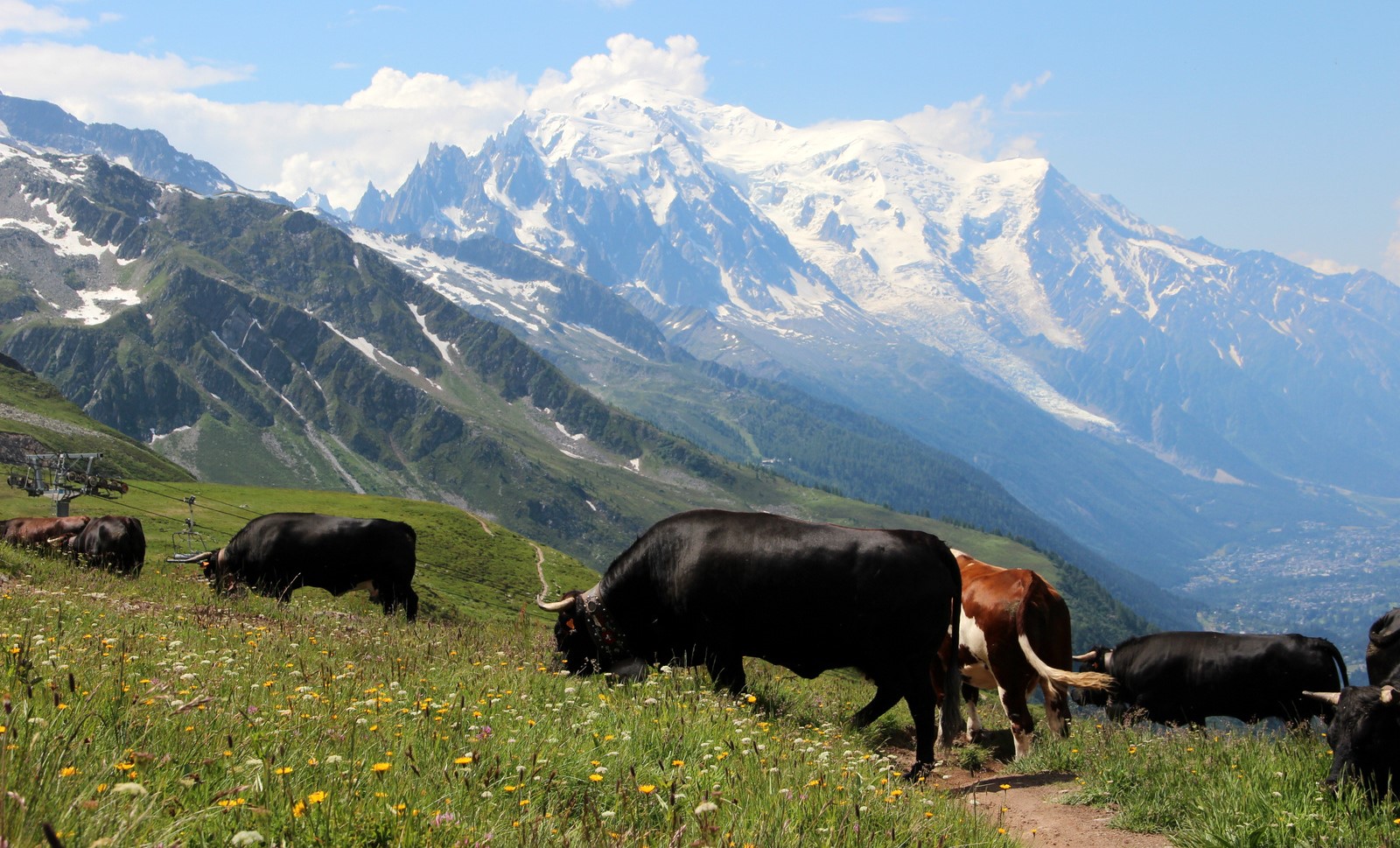
Charamillon alpine meadows
Let us introduce you to those farmers with whom we had the pleasure of chatting. Today, there are around twenty farms in the valley, and we invite you to discover all the points of sale of local produce at the foot of this article.
Montroc farm, between Argentière and Le Tour
When the local farmer Pierre Mugnier retired a few years ago, Franck Pissard took on the Montroc farm. Originally from Cordon, Franck has been living in the valley for eight years with his wife Ivane, an Argentière lass. His farm has thirty dairy cows, and twenty heifers of the Abondance breed. For variety, he also has two beautiful Tarines and one black Hérens. For those who do not know the Hérens breed, this combative cow of Swiss origins arouses the passion of breeders around Mont Blanc.
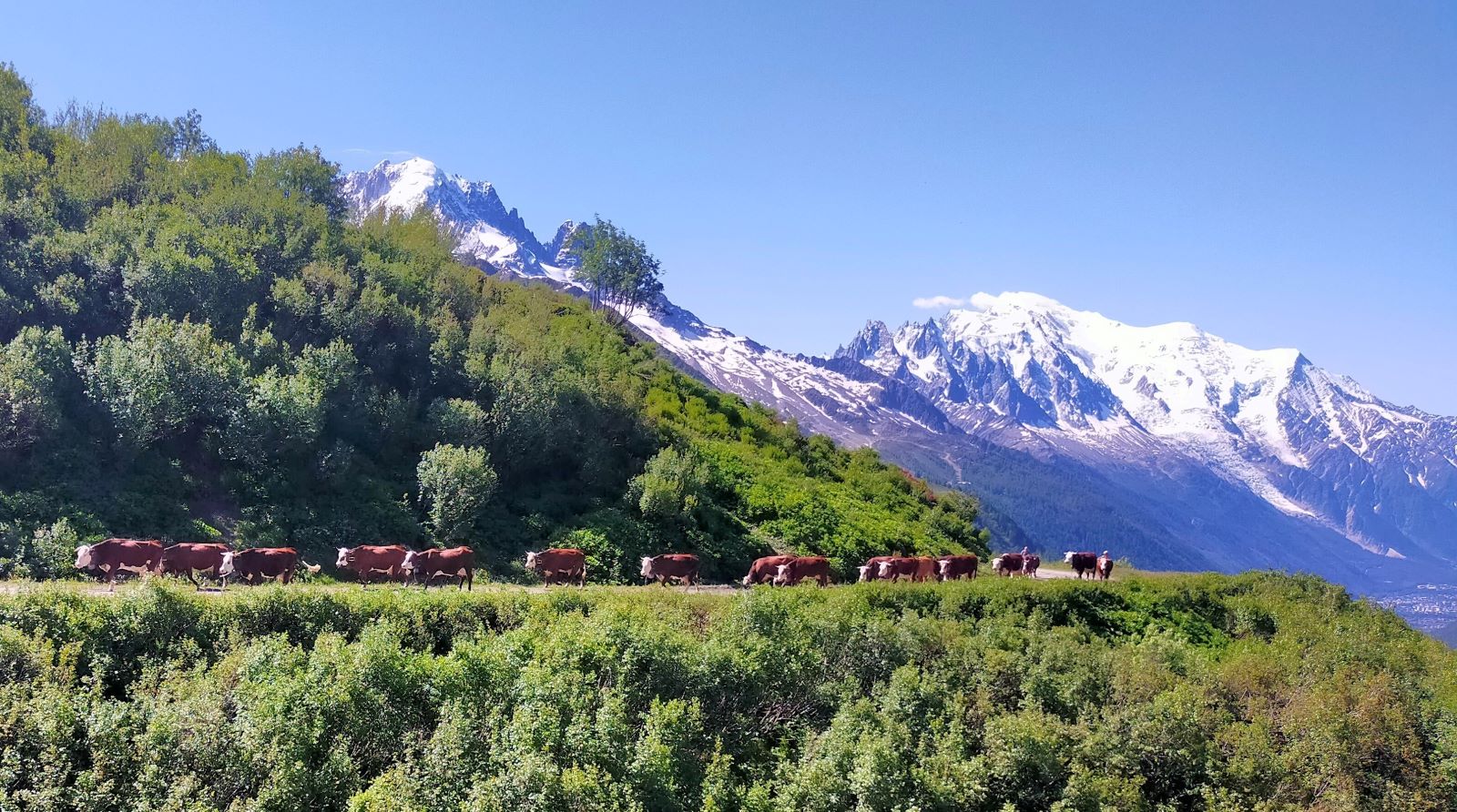
In summer, from mid-June to early September, Franck, Ivane and their two little boys move with the herd up to the Alpage de Balme. This fairly extensive mountain pasture is the most envied in the valley. On a limestone base, the grass here is rich and the alpine flowers are abundant. Even though the cows produce less milk in the summer compared to the winter period, the richness of the alpine milk makes the reputation of the cheeses. The cowshed can accommodate thirty cows and each of them knows its place. The cows are only brought in for milking twice daily and otherwise spend all their time on the hillside. A cheese-making room and a maturing cellar allow on-site processing. They produce essentially mountain Tomme but also a little raclette.

Did you know ? It takes 18 litres of milt to make one Tommes of 1.5 kg !

When the dairy cows come down from the mountain in September, the heifers take their place until the first snow arrives. In the shoulder seasons (spring and autumn) the herd grazes closer to home, around the farmstead at Montroc and here too the meadows have regained their former splendor. The entire milk production (105,000 liters per year) is transformed into cheese. Selling locally, whether on the farm or in the valley stores, allows Franck and Ivane to obtain a fair price for their produce.
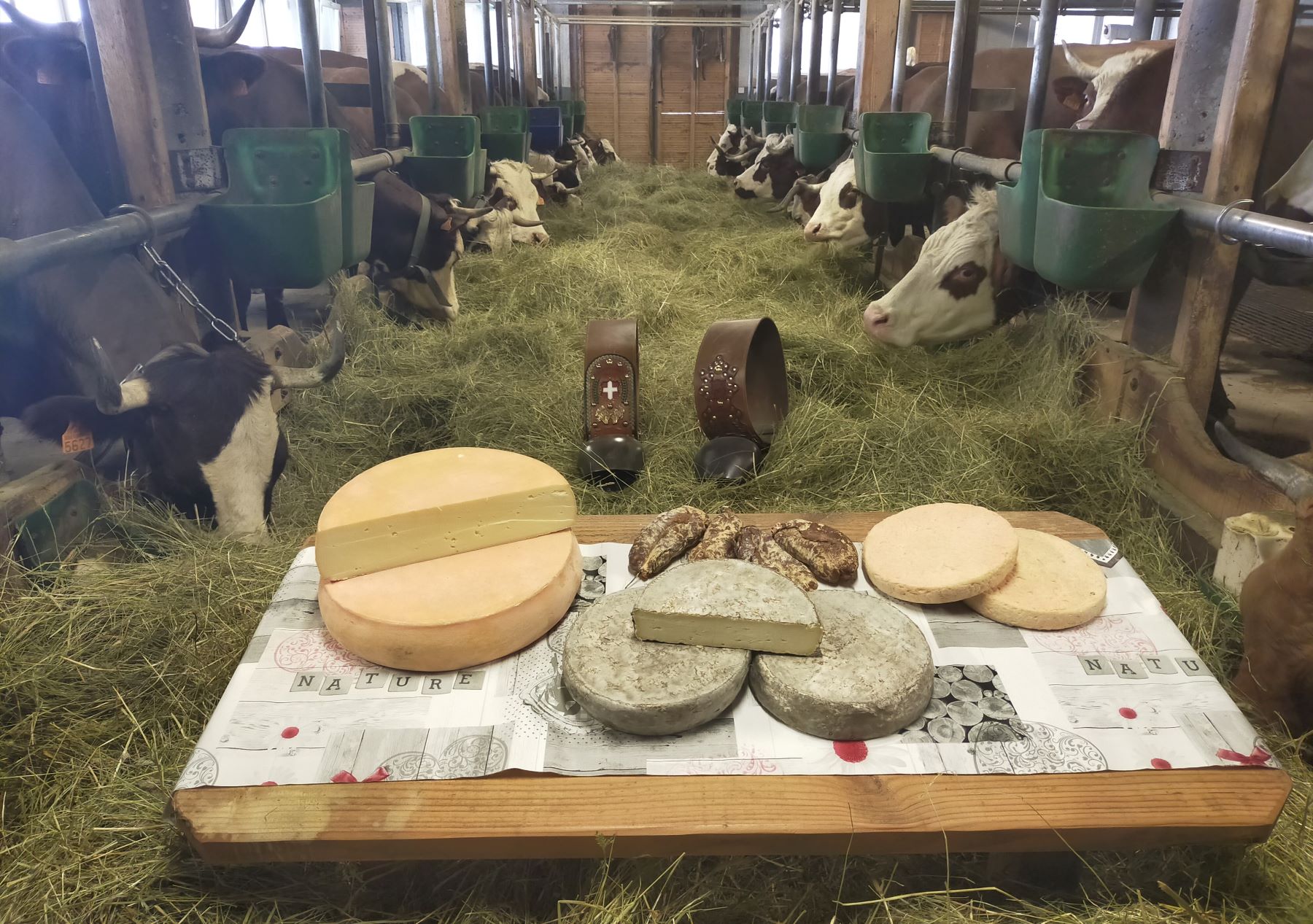
Franck considers himself fortunate to earn a living from his passion. He explains how the numerous avalanche corridors have preserved the upper valley from urbanization, thus giving him sufficient land to make hay for the livestock. Indeed, the winter is long in Montroc (1370m) and during this period the herd stays warm and dry.

Cheese sales at Montroc Montroc farm (above Argentière) all year round on Tuesdays, Fridays and Saturdays from 17h30 to 19h30. Sale at Balme Alpage in July and August.
Vallorcine Farm
Victorien Crepel and Mélissa Banon took over the farm in Vallorcine just two years ago and are very happy with their new life in this high-perched village. Originally from the Aravis hills, the couple had previously both worked in farming and had spent a few summer seasons at altitude before deciding to take the plunge and purchase their own farm in 2021.
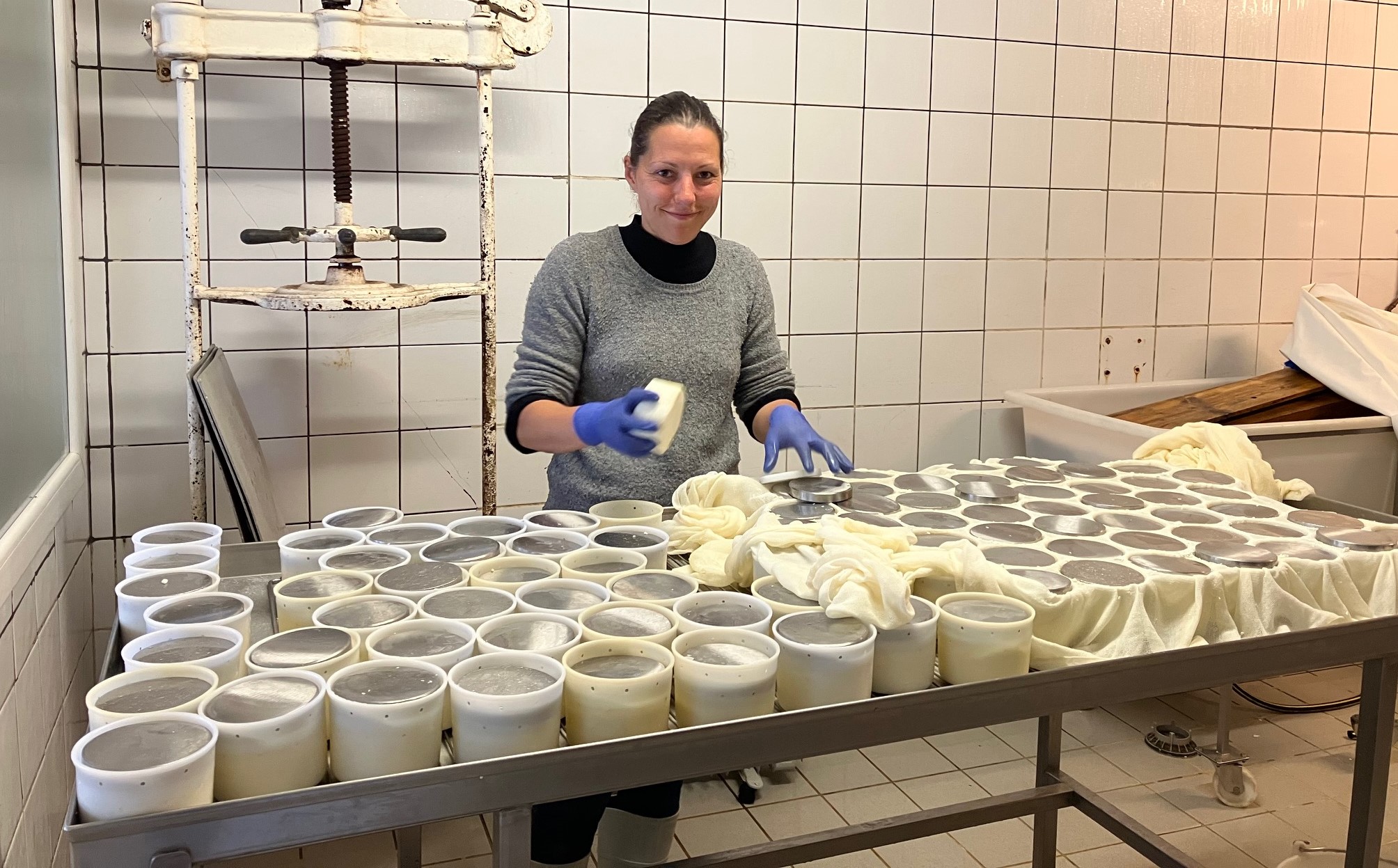
"Many consider the Vallorcine farm to be a crazy venture: a farm with only 20 certified organic dairy cows!
In an era of bigger is better, we are doing the opposite. We decided to have faith in ancient methods with a small, rational structure, respectful of both the environment and the animals."
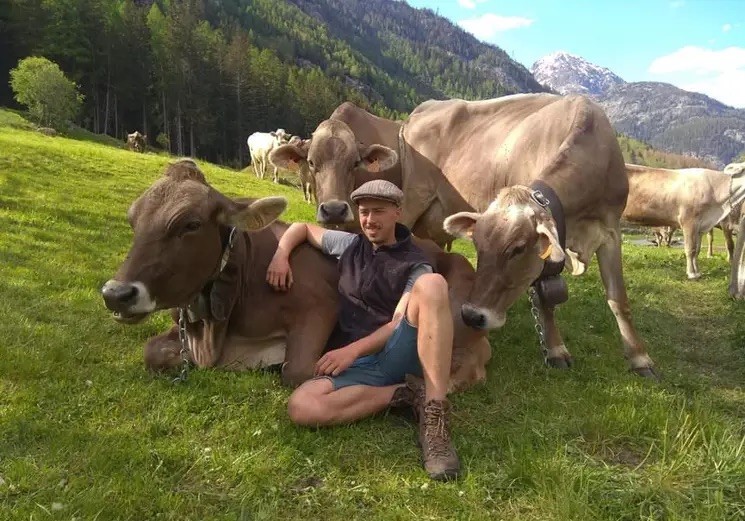
For their exploitation, they chose "The Brown of the Alps". Indeed, Victorien discovered this Swiss breed during a stay in Switzerland and was charmed by its gentle character and hardy disposition. By good fortune, it also produces a rich milk that is very "cheeseable"!
At the Vallorcine farm, all dairy production is processed on site. They produce tomme, raclette, a Gruyère-type cheese, yogurts, cottage cheeses and white cheeses. Perhaps their favourite is the Vallorcin - a soft cheese, very similar to the Reblochon, which simply melts in the mouth!
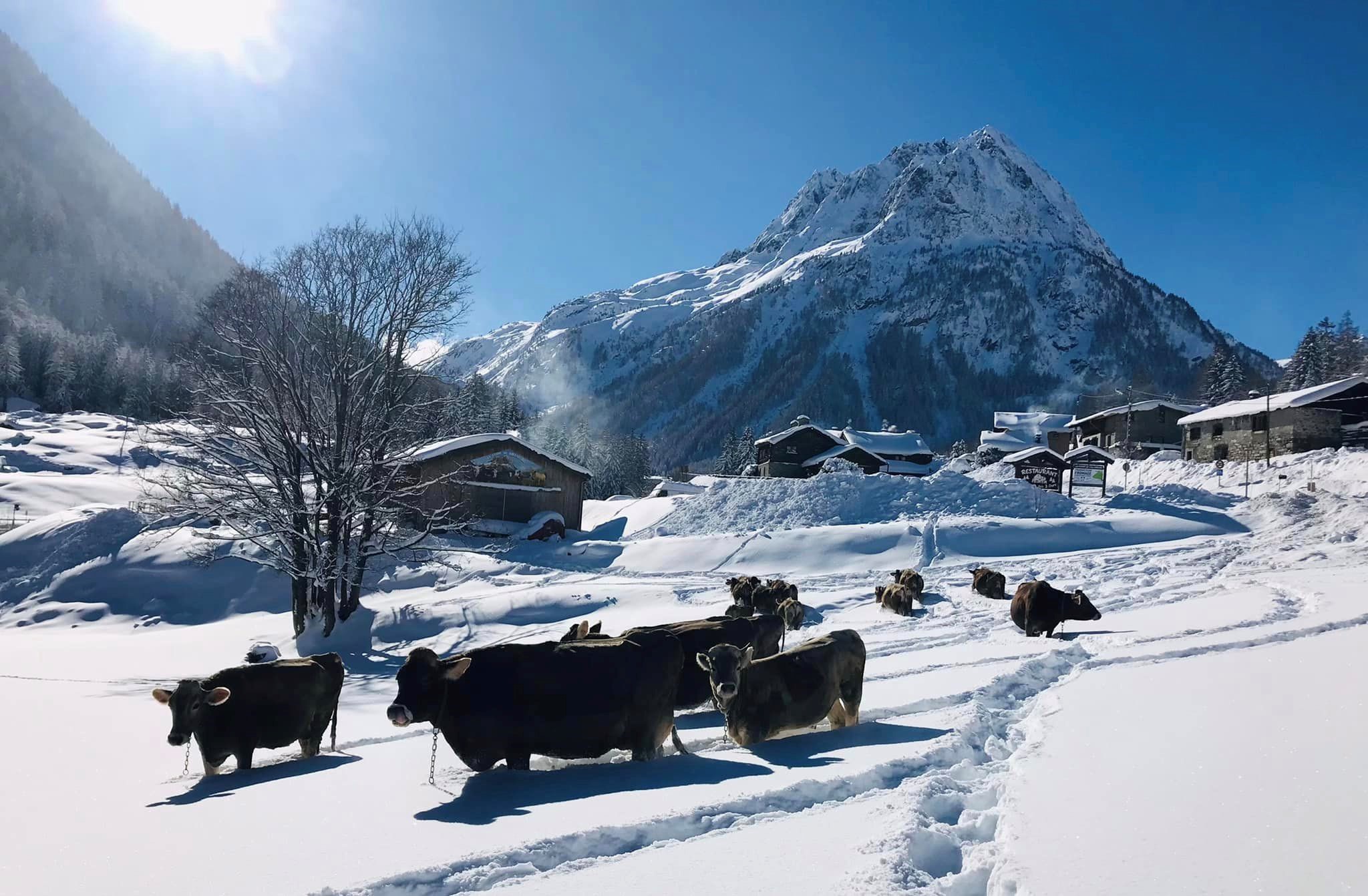
Mélissa and Victorien have also opted for the Organic Agriculture label. The cows graze the meadows of Vallorcine from spring to autumn, and to fulfil the organic label requirements, they also go out in good weather in winter. Walkers and cross-country skiers are sometimes surprised to share the snow with these peaceful brunettes!
Farm sales from Tuesday to Friday from 10h to 12h and from 16h30 to 19h / Saturdays only afternoons and Sundays only mornings. You can also find Victorien or Melissa at Chamonix market every Saturday morning.
Orthaz Farm in Chamonix
Those who like to walk alongside the river Arveyron in the direction of its "Sources" will know where to find the Orthaz Farm. This is where Vincent and Tiffen Fournier raise a flock of sheep and goats.

The farm has existed since 1976 (first run by Christian Fournier, before his son took over in 2001). Vincent and Tiffen joined forces a few years ago and now raise around 800 sheep and around 50 goats. At the beginning of May, it's time to party! After many long months indoors, the animals leave their stabling for the open air with plenty of spring in their step. For approximately six weeks they will graze the avalanche corridors on the floor of the valley (the Moussoux and Pélerins slopes), before heading up to le Tour to graze the lower Charamillon and Balme slopes.
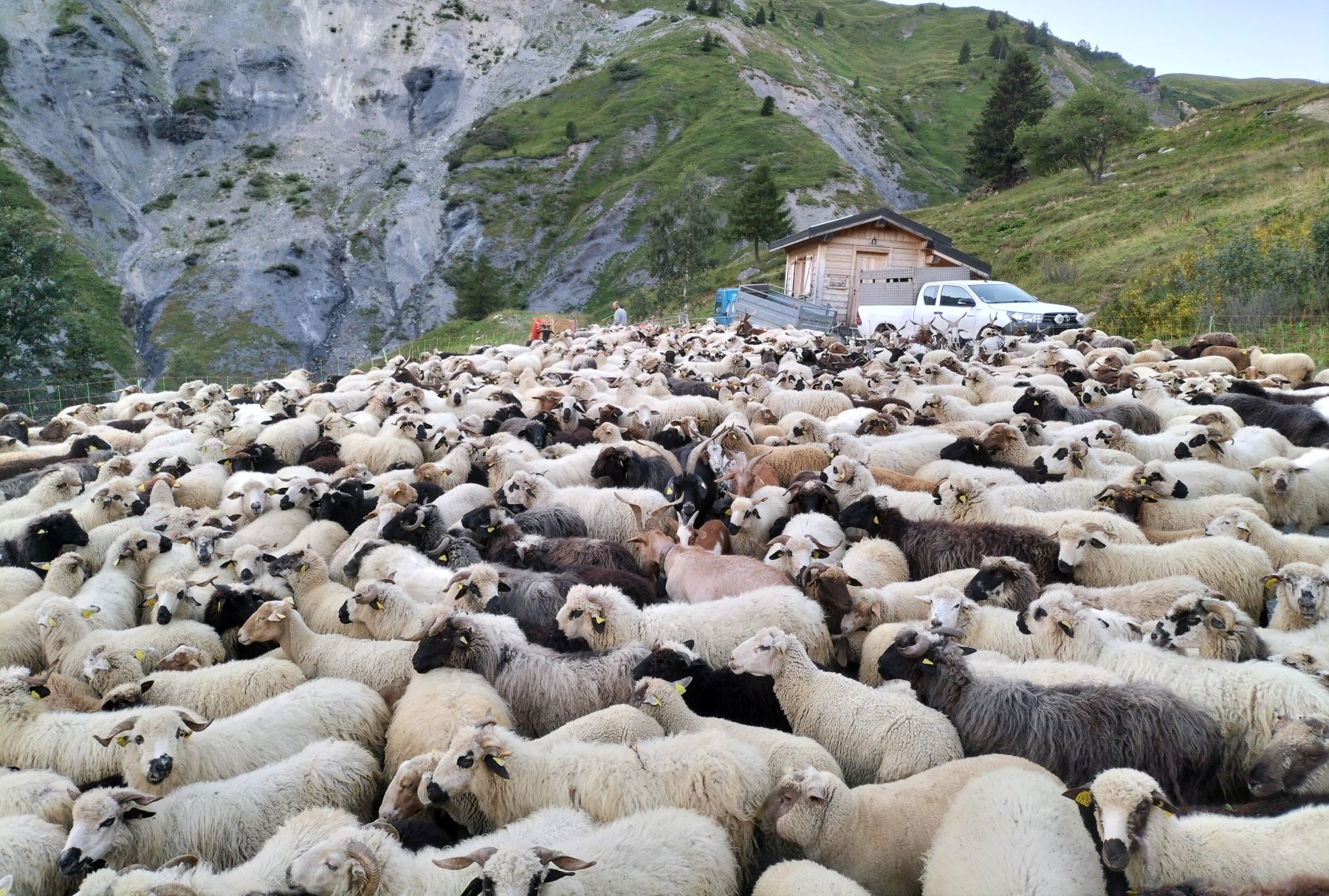
On the slopes above Le Tour
Every year, on the third Friday of July, an agricultural fair takes place in Argentière. For the occasion, the flock descends from the village of le Tour to Argentière where it partakes in the festivities: craft stands, music, refreshments and sale of local produce. The flock will then migrate its new grazing land on the Flégère mountain, accompanied by Vincent, Tiffen and about fifteen protective dogs. They will remain at La Flégère for around two months, before returning to the slopes of the Tour for the latter part of the summer season. They will only return to the lower valley around mid October and back to the Orthaz sheepfold one month later, depending on the weather.
Lambing and kidding takes place in December when the flock is warm and dry in the sheepfold. This avoids having vulnerable youngsters on the mountainside during the summer months.
La Ferme des Trois Terres, les Chavants - les Houches
Jérôme Garcin has been raising cows since the year 2000. He has a passion for the black "queens", the Hérens breed from Switzerland. He built his farm in Les Chavants in 2009, and now has a herd of thirty dairy cows and heifers. He maintains around thirty hectares of land in the commune of Les Houches.
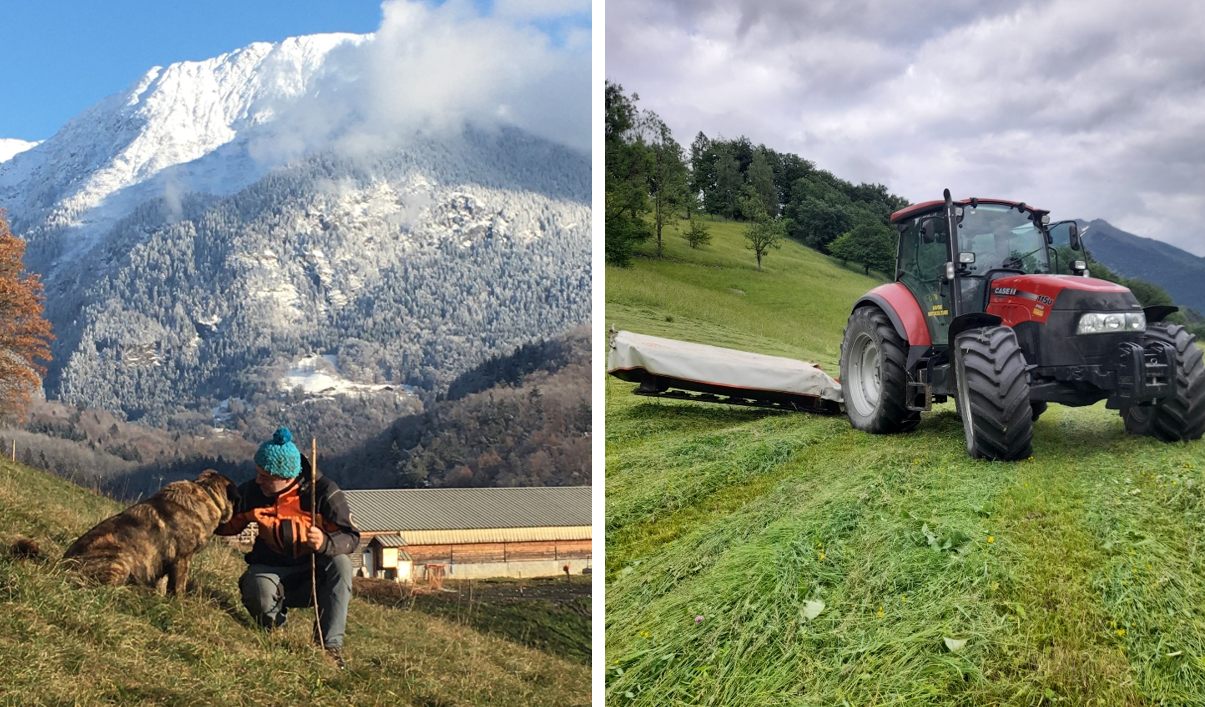
In summer, Jérôme moves his cattle up valley to the mountain pastures of Charamillon (Le Tour) where they join the herds of René Ravanel (Argentière) and Pierre Choupin (Les Houches). When the black beauties meet up on the mountain pastures, there will be plenty of frolicking and a few beefy battles, where the winner assumes leadership of the troops!
"Nobody forces them to fight, it's in the genes of the Herens breed, they are very headstrong! They all want to be the boss, but no, there is only one queen on the mountain!" says Jérôme Garcin.
The traditional cow-fighting tournament takes place annually in the Mont-Blanc region
In the past, the Alpage de Charamillon could accommodate 90 dairy cows, and as all of them came from small herds, a hierarchy had to be established in the mountain pastures. The fights at the beginning of the season were numerous and the owners followed the performances of their valiant blacks with much enthusiasm.
Since 2020, Jérôme, Claire and their children have diversified their activities. They raise 80 alpine chamois goats and make cheese on their recently acquired "Trolles" goat farm in Passy.
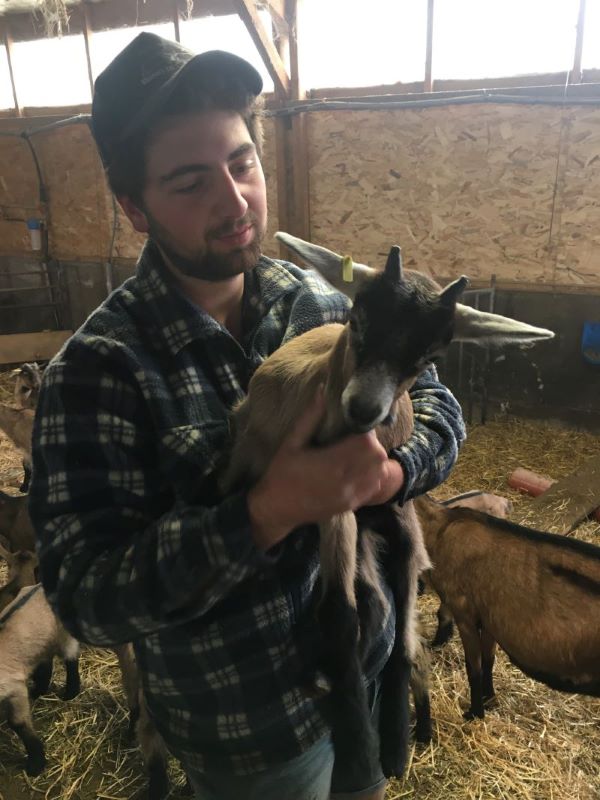
Marceau Garcin with his goats
Jérôme also presses apples and pears from his orchards in Les Houches to produce delicious local juices. He plants fruit trees every year to recreate high-stem orchards of local and old varieties.
Claire, director of the Animal Park of Merlet, also exploits forest land beneath the park at an altitude of 1500m, where she raises a delightful breed of free-range woolly pigs.
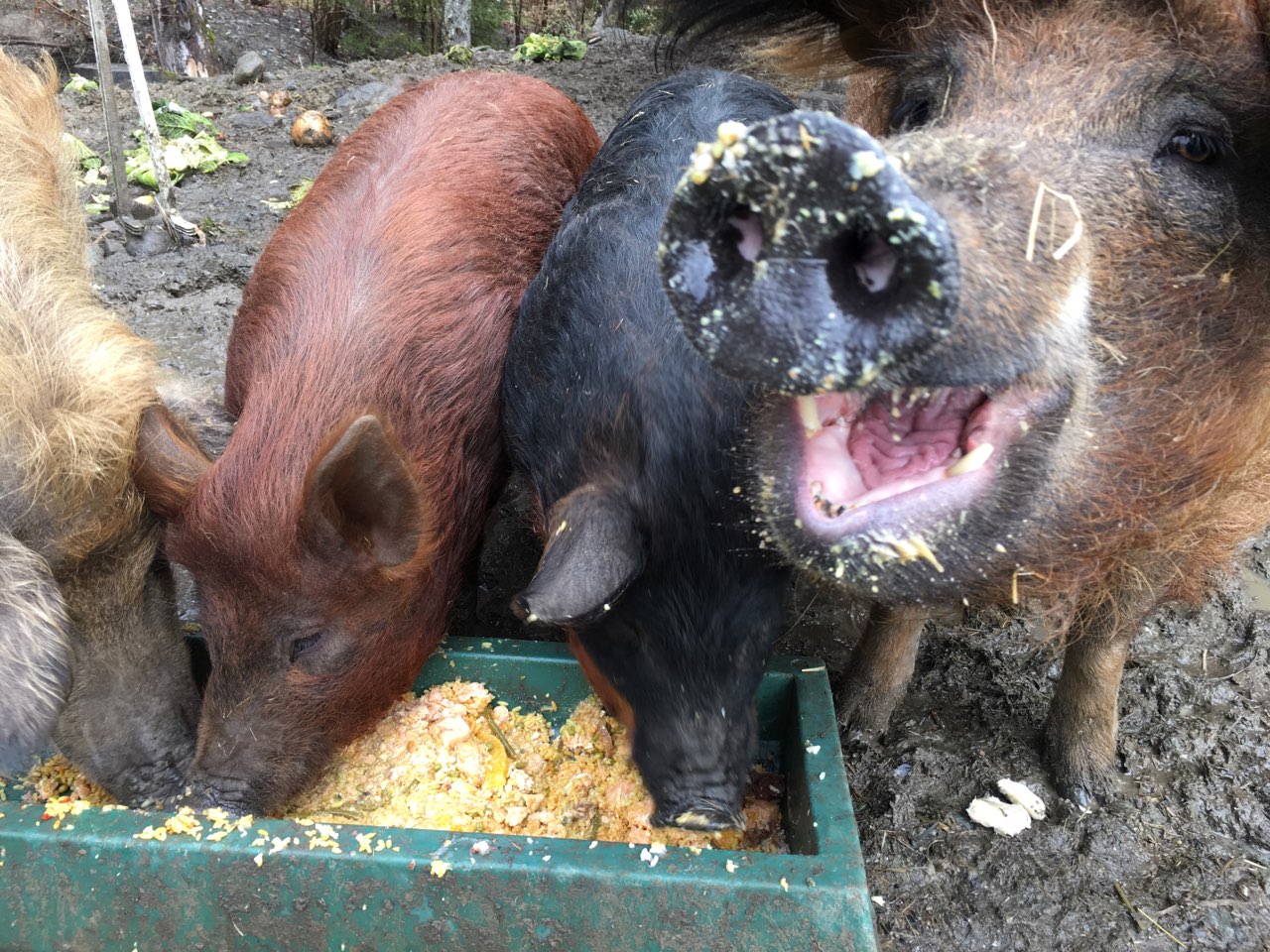
Claire Cachat's woolly pigs
Book your box of veal meat from February to April and beef in the autumn. Depending on the season, sale of goat's and cow's cheeses as well as sausages and terrines. Book directly on 06 86 89 28 80. More info on farm products at Les Trois Terres
Tom Scott's farm, les Houches
Originally from Perthshire in Scotland, Tom grew up on a small farm surrounded by cattle, sheep, goats and poultry. Trish, his wife, comes from a much larger farm in Australia that raised cattle and sheep.
Tom arrived in the valley in 2003 and immediately became interested in the different forms of agriculture possible in the Alps. He soon felt the need to get back to farming so, with his wife Trish, they began by purchasing seven ewes. They now have a flock of 200 Thônes and Marthod sheep, as well as a few goats, poultry and beehives.
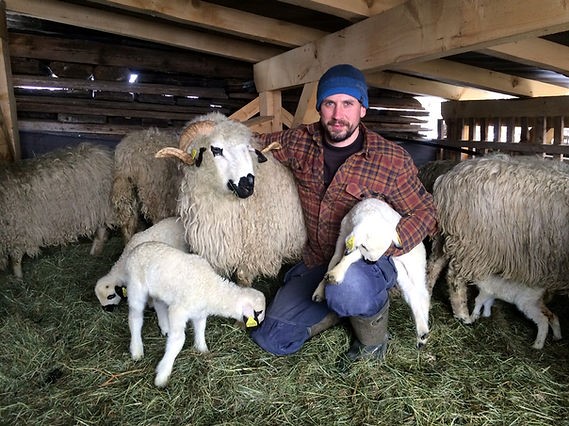
In winter his flock is spread between his sheepfold in Bellevarde, Les Houches and another in Le Bois. Above his farm is the small mountain pasture of Grand Bois where part of his flock grazes in spring and autumn, whilst the remainder are committed to eco-grazing in the commune of Chamonix.
From mid-June to September, his flock (increased to approximately 350 animals following lambing) resides in the mountain pastures of La Pendant, above Argentière. Tom stays there with his animals throughout the summer, accompanied by his six guard dogs: Anatolian Shepherds (Turkey), Serra da Estrela and Transmontano (Portugal).
The Pendant mountain once accommodated around sixty cows, before being abandoned in the 1960s. Subsequently, the grassland was in such poor condition that it has taken many years of natural maintenance by goat and sheep herds to reclaim the land and to regenerate the alpine meadows seen today. We salute the committment of both the migrational shepherds from the south of France and the consorts. The chavanne, rebuilt in 2006/2007, offers a good roof to the current shepherd, Tom Scott.
Seasonal migration from Argentière to la Pendant in 2012 with Provencal shepherd Jean-Luc Pitra and his 1200 animals
Like many other farmers in the valley, Tom cannot expand his herd because there is insufficient winter barn space. He is also obliged to buy in hay because he does not have land to make hay locally. He would love to develop the sheep's cheese sector but for the moment, this remains a dream!
In November, reserve your box of lamb's meat (approx 15kg) with Tom Scott: +33 (0)6 10 61 93 63.
Blaitière sheep farm
Nestled on the northern slopes of the Chamonix valley, Blaitière mountain pasture is located at an altitude of 1708m. Since 2021, a young couple of shepherds and their sheep have made Blaitière their summer residence. Carine and Thomas Gardiennet, originally from the Doubs region of France, made a lifestyle change a few years ago, and decided to become alpine farmers. Carine was previously an intensive care nurse and Thomas a project manager, but their passion for the mountains and agropastoralism took over.
Every summer, from June to September, they take up residence, along with their sixty Thônes-Marthod and Lacaune ewes on the heights of Chamonix.
Thanks to the Consorts of the Montagne de Blaitière, the farm facilities were entirely renovated in 2021, thus doubling the space dedicated to the animals. In addition to the milking parlor, there is a closed barn where the sheep overnight in order to protect them from predators, in particular the wolf! During the daytime the sheep graze leisurely uphill towards Blaitière-Dessus at 1900m, in the company of either Carine or Thomas who ensure their protection.

Blaitière mountain
Out of concern for the environment, Blaitière is not accessible to vehicles, but a freight elevator, installed in 2013, is very useful for transporting supplies!
The sheep are milked twice daily and the cheese is made on site. The shepherds sell their produce at Blaitière and offer cheese tastings and gourmet dishes to hikers. Carine is dedicated to the promotion of wool: she shears her sheep, treats the wool and makes clothing and accessories. This summer wool felting workshops are organised on site in July and August).
Blaitière can be reached on foot from Chamonix in two hours, or from the Plan de l'Aiguille (descent) in 1.5 hours.
The migration of the sheep to Blaitière takes place in June (this year on Saturday June 10, 2023). To be a part of this pastoral procession, register at the Chamonix tourist office: tel. +33 (0) 450 530 024
Marc Ouvrier-Buffet, farmer in Servoz
Marc grew up surrounded by animals at home: chickens, rabbits, sheep, goats, cows. His parents passed on to him their passion for the "old-fashioned" farm.
At the age of seven, he was gifted a Thônes et Marthod lamb and at the age of 10, he was given his first calf, offered by the Servoz farmer Rémi Deschamps. The legacy he received from his predecessors is a small farming model, close to nature and respectful of livestock.
With his companion Anne, who, prior to meeting Marc, was a transhumant shepherdess, they have developed the farm and made it viable. They have 200 nursing ewes and raise alpine lambs. The flock spends the summer months on the mountain pastures of Platé, guarded by Anne and four dogs. On their farm in Servoz farm they also have a dozen Hérens cows and raise milk-fed calves.
"What we are defending is not only viable agriculture for the farming community in the valley, but also a precious natural and cultural heritage that must be protected and cherished in order to pass it on to future generations."
Marc offers boxes of Thônes and Marthod lamb from September to November and suckling veal from December to April. To book: +33 6 60 05 36 34.
Here are some more addresses for farmer's markets and local farm sales:
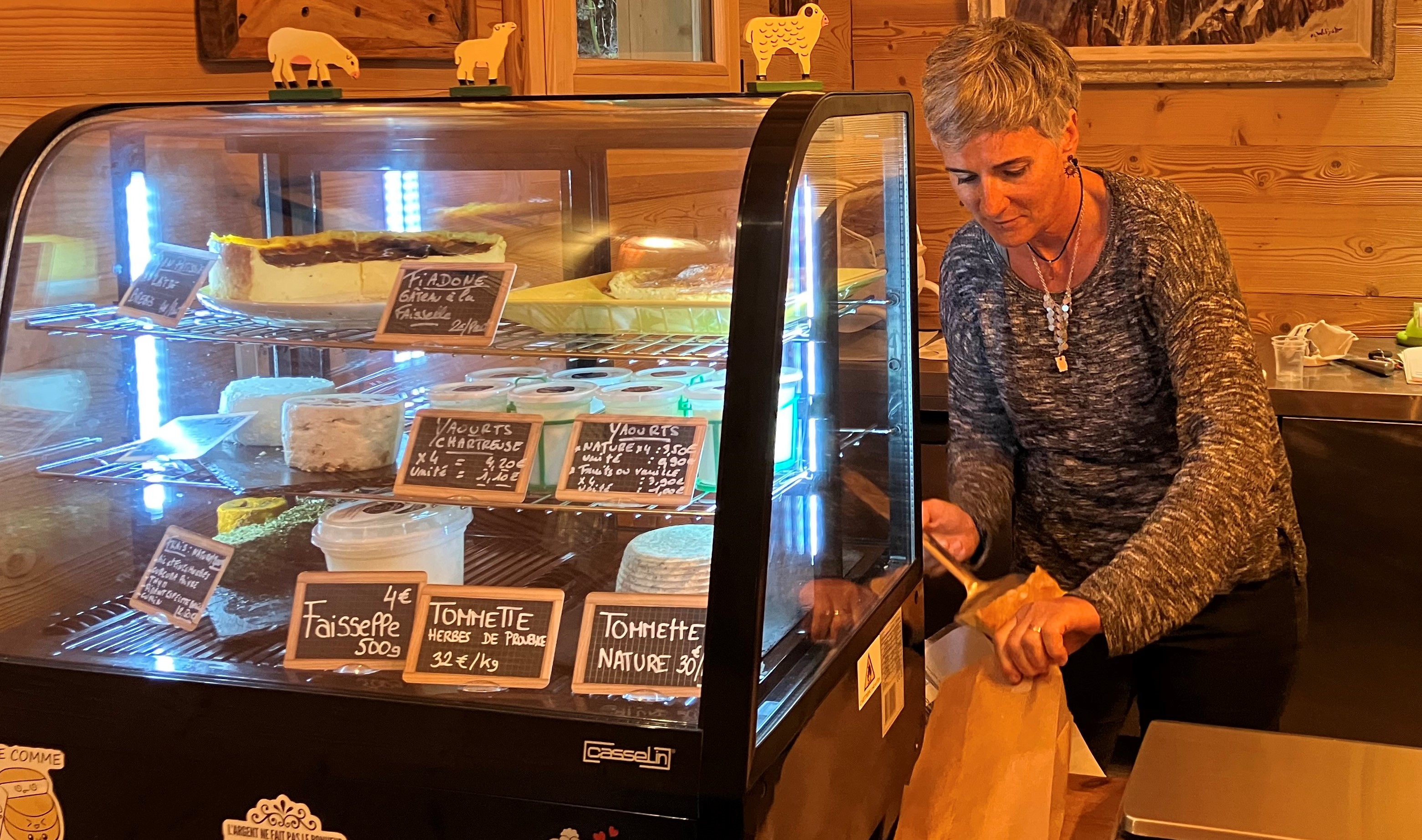
Géraldine welcomes you at the Croets Mastins Farm in Les Houches
Eddie and Géraldine Battendier "La Fromagerie des Croets Mastins", allée des Diligences aux Chavants, Les Houches
Sale of farm products made from ewe's milk and breeding of alpine lambs in Chailloux. Store open Monday to Saturday from 4:30 p.m. to 6:30 p.m.
Gerard Berrux, craft baker "Le pain de Chibon", 427 route du Pont, Les Houches
Find Gérard's natural sourdough bread every Wednesday afternoon on his farm, at the farmers' market from 3 p.m. to 7 p.m., or at Servoz market on Friday evenings and on the Carrefour Market car park on Tuesdays from 3 p.m. to 7 p.m.
Noé Tollin, "Safran du Mont-Blanc", Les Houches
A small farm which cultivates saffron entirely by hand, enhancing its production with saffron seasoned products: homemade jams, honeys, mustards, vinegars...
Direct sales at the Chamonix market every Saturday from 7:30 a.m. to 1:30 p.m.
David Vallas, organic market gardener in Vallorcine "Les Petits Fruits Rouges Bio"
In harmony with the seasons, David sells his garden produce locally in Vallorcine in the form of fresh vegetables and fruit as well as conserves, coulis, cordials, jams and caramels
At the farm, by appointment. Tel: +33 (0)6 83 97 94 52
Patrick Ancey, breeder of cows, pigs and goats in Vallorcine
Sale of cheese and meat at the farm: +33 (0)6 34 21 33 32
Hélène Jallot, craft baker "L'Eco Pain D'Abord", Vallorcine
Baking of batches on Tuesdays and Fridays! Book the day before on +33(0)6 89 65 53 65 (before 8 p.m.) Pick up your bread either at the bakery, 254 route de l'église, or in front of the Argentière super U on Saturdays from 9 a.m. to 12:30 p.m.

A SHEPHERD IN MY SCHOOL
Tiffen from the Orthaz farm and Ivane from the Montroc farm take part in this educational initiative to raise children's awareness of wildlife and mountain farming.
Intended for children from urban and rural communities, from the first year of kindergarten through to secondary school, the annual program is made up of highlights:
- Farmers pay a visit to schools in the valley (Tiffen takes along a lamb and Ivane brings milk from the farm)
- Class work with the teacher and with the help of educational tools
- An outing to the mountain pastures to meet the shepherd (in June) and for the little ones, a visit to the farm.
Anecdote ...
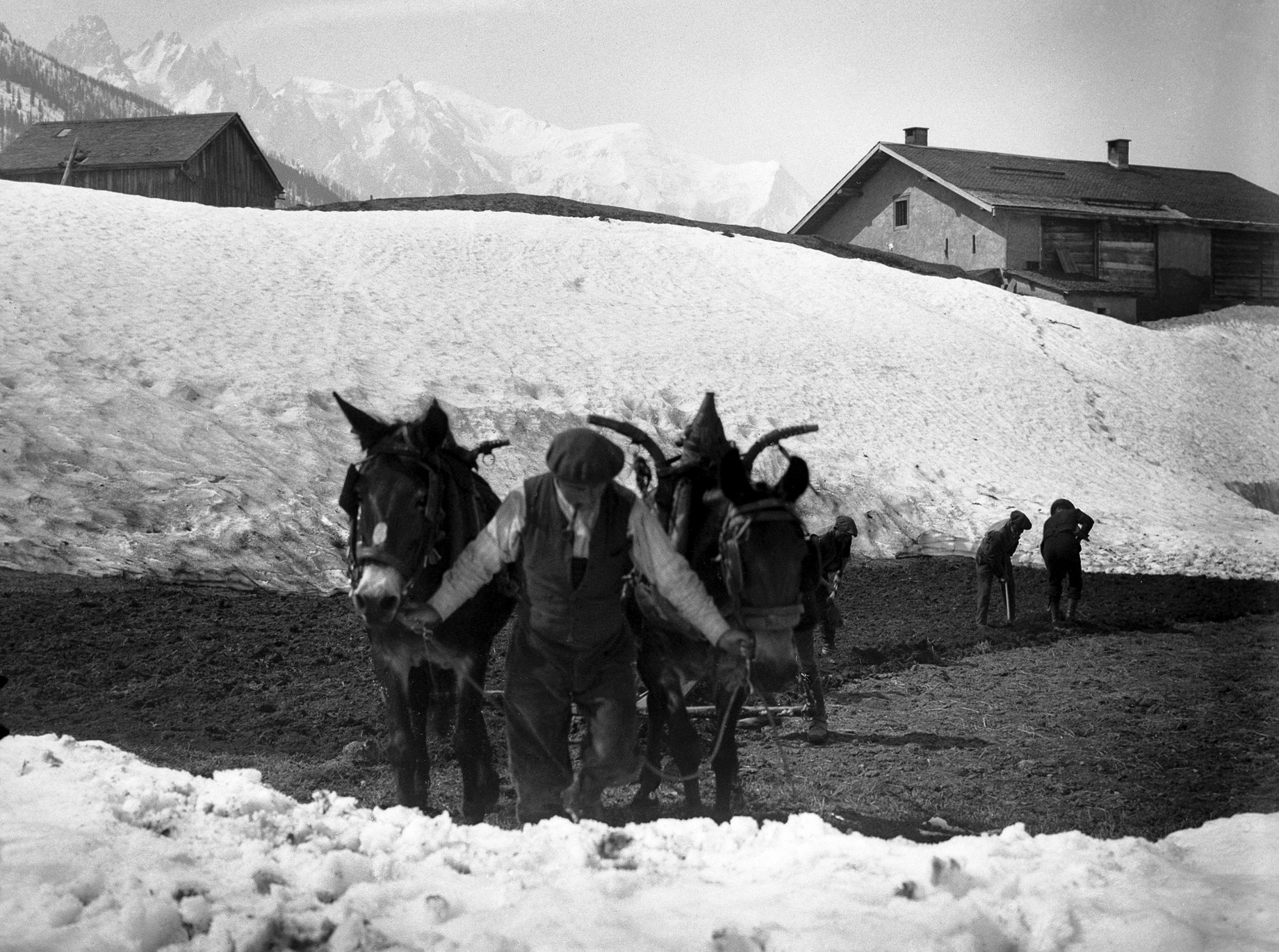
In the past, many families owned a mule for farm work. With the development of tourism, the mules adopted a double activity, just like their masters! Tourists rode astride these sturdy beasts during the summer months in order to access Montenvers-Mer de Glace and Planpraz-Brévent.

The Mule Fair (an equine MOT test), held every year in May was a highlight in the Chamonix agenda! Indeed, during this fair, between 250 and 300 animals underwent a veterinary visit to attest to their good health and above all their impeccable manners!
Cogwheel trains and ski lifts put an end to this activity, but the electric "mules" in the centre of Chamonix are reminiscent of a bygone era!
With thanks and acknowledgements :
Christian Ducroz, Joëlle Paccalet et tous les agriculteurs qui ont pris le temps de répondre à nos nombreuses questions.